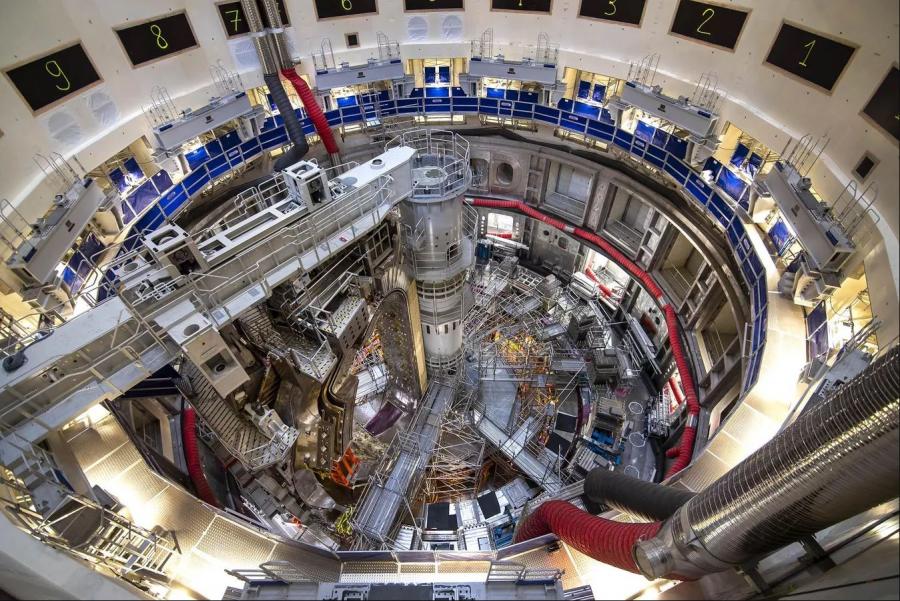Over the past three months, the International Thermonuclear Experimental Reactor (ITER), which is being built in the south of France, has been found to have a number of technical defects in the delivered structural elements, the assembly of the tokamak has been suspended, and the time for the first launch of the reactor will be postponed. However, scientists remain optimistic about the end date for obtaining the deuterium-tritium reaction in 2035.

The International Thermonuclear Experimental Reactor under construction
ITER is being built in order to prove the possibility of using thermonuclear fusion as a safe, environmentally friendly and, most importantly, a practically inexhaustible source of energy. When the desired result is obtained experimentally (it was supposed to happen in 2035), it will be possible to begin the detailed study of commercial fusion power plants.
But the launch of any installation of this level consists of many stages. In the ITER tokamak, it is planned to first obtain the "first plasma" - hydrogen, then helium, deuterium, and only then deuterium-tritium: it is this mixture that is considered the most efficient fuel for a thermonuclear reactor under terrestrial conditions. Obtaining the "first plasma" was scheduled for 2025. However, last November it turned out that there were too large gaps between the sectors of the vacuum chamber (the key element of the reactor, the internal volume of which is 1400 cubic meters, the outer diameter is 19.4 m, and the weight is about 5200 tons), and their high-quality welding is impossible.
And in the cooling tubes of the thermal screen (separating the hot and cold zones of the reactor), cracks were found - it is impossible to eliminate such a defect on the spot. It is not yet clear how the construction schedule and the research program will change in connection with this, decisions on these issues will be made by the ITER Council, the next meeting of which is expected in the spring.
The ITER project involves the countries of the European Union, Russia, the USA, China, South Korea, India and Japan. Five sectors of the vacuum chamber are being built by the European Union, four by South Korea; who made a miscalculation is not yet reported. Russia, which is to prepare a total of 25 systems for ITER, continues to cooperate with the project, despite sanctions complicating logistics. Moreover, all systems are delivered from Russia on time and of good quality.
Yuri Gasparyan, associate professor of MEPhI, acting Head of the Department of Plasma Physics, which is developing for ITER, believes that one should not lose optimism about the timing of the final date for obtaining the deuterium-tritium reaction in 2035.
“The main thing is that these errors happened at the initial stage of assembling the tokamak, and their causes will be taken into account at the next stages - it would be much worse if the problems were identified already in the finished object,” says Yuri Gasparyan. “The very term for launching the “first plasma” is a conditional concept, meaning that the installation is assembled in a minimal configuration and the first launches are being made in it.”
MEPhI is also entrusted with the training of scientific personnel for work at ITER, and even if the deadlines are slightly pushed back, this will give more time to solve this problem. The largest contract between the nuclear university and ITER is the development of a system for collecting and diagnosing dust (wall erosion products) in the reactor, which is also not required during the first launches of the facility.
“The identified constructive and organizational problems arising from them will not affect what is being done at MEPhI for this project,” Yuri Gasparyan stressed. - Many believe that the research program between the "first plasma" and deuterium-tritium will be tightened, probably something will have to be sacrificed. But the most important thing is that the project has already become tangible - the main elements have been made, most of the infrastructure is ready, assembly has begun, and if something even has to be made again, it's not scary, since all the technologies have already been worked out. Technical difficulties have happened at ITER before, it is possible that similar situations will arise in the future as the object is too large and complex for everything to work out perfectly the first time. The launch, if postponed, is by two years. But in any case, the assembly of the tokamak itself is already underway, it is already there, you can touch it, and more recently, its construction seemed to be something almost from the realm of fantasy.”





